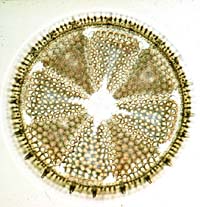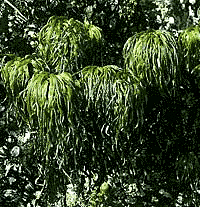







Members of the Chromista are almost all aquatic organisms. These may occur, however, in both freshwater and marine environments. The Phaeophyta, for example, are primarily known for their large marine kelps, but the group also includes microscopic freshwater species. Likewise the diatoms have many marine and freshwater groups.
Chromists make their living in the aquatic enviroment in several ways. Many are planktonic like the diatoms and Sargassum, floating free near the water surface, and being carried along by the surface currents. Other chromists, such as the large kelps, are attached to the bottom of the ocean, but are so incredibly large that they may reach to the surface, and form kelp forests in the ocean.
 |
 |
Important Chromists : On the left, a living diatom; millions of these microscopic chromists inhabit the world's oceans and are an important source of food for marine life. On the right, several "sea-palms" (Postelsia). Despite the vast difference in size, both chromists are important as aquatic vegetation and both have similar chemistry.
Many chromist groups are photosynthetic, using colorful pigments to capture the energy of sunlight to fuel the manufacture of food. Because of this, chromists are often the most important primary producers in aquatic ecosystems, forming the base on which the food chain is built. Diatoms and coccolithophores particularly are important sources of food for small aquatic predators. Some of the chromists are non-photosynthetic, and so must obtain their food from living or decaying matter. The Oomycota may be found growing as fluffy white parasites on the scales of fish.
Many chromists rely on silica to construct a rigid skeleton around their cells. These silica skeletons are formed by deposition of minerals within the Golgi apparatus. Some chromists are quite efficient at extracting the silica they need from the surrounding water, and are capable of quickly depleting dissolved silica -- cultured diatoms raised in glass containers will weaken the container walls! Because some planktonic diatoms may divide up to eight times per day, there is a constant need for more silica. As the diatoms die, they sink to the ocean floor, becoming a thick ooze of decomposing matter, and eventually giving rise to deposits of the sediment called diatomaceous earth. Other chromists, like the coccolithophores, produce skeletons of calcium carbonate, in much the same way. Deposits of their skeletons produced much of the Mesozoic chalk and limestone.
You can view a recreation of a kelp forest in an aquarium tank at the Stephen Birch Aquarium Museum at the Scripps Institute of Oceanography in San Diego. Or visit the marine plants database of the DELTA Project for pictures and information on marine algae of California as well as other marine organisms.


